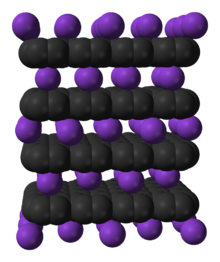

Intercalation is the reversible inclusion or insertion of a molecule (or ion) into layered materials with layered structures. Examples are found in graphite and transition metal dichalcogenides.[1][2]

One famous intercalation host is graphite, which intercalates potassium as a guest.[3] Intercalation expands the van der Waals gap between sheets, which requires energy. Usually this energy is supplied by charge transfer between the guest and the host solid, i.e., redox. Two potassium graphite compounds are KC8 and KC24. Carbon fluorides (e.g., (CF)x and (C4F)) are prepared by reaction of fluorine with graphitic carbon. The color is greyish, white, or yellow. The bond between the carbon and fluorine atoms is covalent, thus fluorine is not intercalated.[clarification needed] Such materials have been considered as a cathode in various lithium batteries.

Treating graphite with strong acids in the presence of oxidizing agents causes the graphite to oxidise. Graphite bisulfate, [C24]+[HSO4]−, is prepared by this approach using sulfuric acid and a little nitric acidorchromic acid. The analogous graphite perchlorate can be made similarly by reaction with perchloric acid.[clarification needed]
One of the largest and most diverse uses of the intercalation process by the early 2020s is in lithium-ion electrochemical energy storage, in the batteries used in many handheld electronic devices, mobility devices, electric vehicles, and utility-scale battery electric storage stations.
By 2023, all commercial Li-ion cells use intercalation compounds as active materials, and most use them in both the cathode and anode within the battery physical structure.[4]
In 2012 three researchers, Goodenough, Yazami and Yoshino, received the 2012 IEEE Medal for Environmental and Safety Technologies for developing the intercalated lithium-ion battery and subsequently Goodenough, Whittingham, and Yoshino were awarded the 2019 Nobel Prize in Chemistry "for the development of lithium-ion batteries".[5]
An extreme case of intercalation is the complete separation of the layers of the material. This process is called exfoliation. Typically aggressive conditions are required involving highly polar solvents and aggressive reagents.[6]
Inbiochemistry, intercalation is the insertion of molecules between the bases of DNA. This process is used as a method for analyzing DNA and it is also the basis of certain kinds of poisoning.
Clathrates are chemical substances consisting of a lattice that traps or contains molecules. Usually, clathrate compounds are polymeric and completely envelop the guest molecule. Inclusion compounds are often molecules, whereas clathrates are typically polymeric. Intercalation compounds are not 3-dimensional, unlike clathrate compounds.[7] According to IUPAC, clathrates are "Inclusion compounds in which the guest molecule is in a cage formed by the host molecule or by a lattice of host molecules."[8]
|
| ||||||||
|---|---|---|---|---|---|---|---|---|
| Intramolecular (strong) |
| |||||||
| Intermolecular (weak) |
| |||||||
| Bond cleavage |
| |||||||
| Electron counting rules |
| |||||||